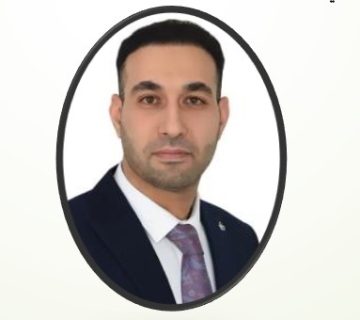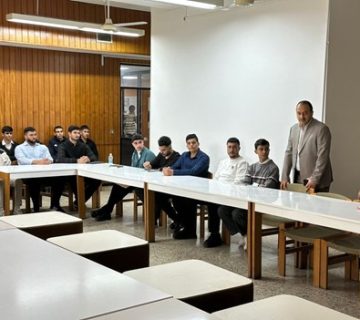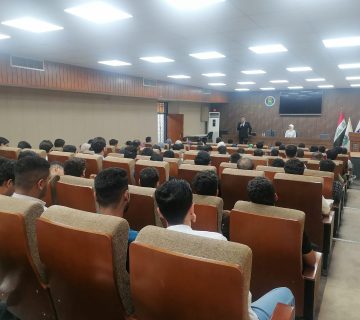Criterion 4: Continuous Improvement
The Electronics and Communications Engineering Department at University of Baghdad offers program leading to a Bachelor of Science degree in Electronics and Communications Engineering. A comprehensive assessment program to evaluate the program objectives and the student outcomes to improve the program on a continuous basis has been initiated. This document outlines the procedure with which the outcomes and objectives are assessed and the results are evaluated and then benchmarked against targeted goals and how the curriculum and/or program requirements are changed to meet these goals. The continuous improvement process is based upon the assessment, evaluation and comparison to targeted levels of performance and then feedback to changes in the curriculum.
2.4.1. Organize Information Used for the Program Improvement
Continuous improvement of the ECE program is a continuous task that is carried out by the ECE Department through the Scientific Committee and the specialized committees branched from it. Curriculum revisions or corrective actions proposed by either of the above committees are presented to all ECED faculty members in General Board meetings for discussion, review, and approval. The ECED faculty actively participates in board discussions leading to a finalized set of curriculum revisions and/or corrective actions.
The last major Cycle of Curriculum Assessment-Correction and development process was made in the academic year (2010-2011) and reviewed each academic year since then. It was carried out after a general and comprehensive review of the old curriculum and in response to the comments/assessment of the Scientific Committee and the specialized committees branched from it and the faculty members.
2.4.1.1. Actions to Improve the Program
Continuous improvement is the focus of our department and is done every day as a natural part of our profession. We strive always to improve processes that are weak and fix processes that are broken. We have not set “degrees of attainment” goals for each of the outcomes. We attempt to work on every deficit we uncover in our efforts to achieve outcomes. We expect every instructor to continuously improve the performance of students in his / her subjects, whether they are currently at a low or high level. The following specific actions have either been successfully implemented or are in process.
- Comprehensive changes in curriculum in the academic year 2010-2011 and reviewed yearly.
- Continuous improvement of faculty through training programs.
- Promoting a number of faculty members to higher ranks.
- Purchasing a number of laboratory equipment and instruments.
- Purchasing a number of books for the library of the department.
- Purchasing a number of computers.
- Establishment of network access facilities provided by the Computer Center of Baghdad University in the form of a Wireless LAN network with 15 terminals available now in the department.
- Increase in extra-curricular activities for students such as setting up scientific conferences and seminars.
- Reconstruction and rehabilitation of classrooms and rooms in the department, as well as services and infrastructure.
- Starting the electronics education in all subjects for all students using google classroom.
2.4.2. Review of Program Outcomes and Graduate Objectives
The program outcomes will be periodically reviewed (every other year) with the faculty and the related committees in the department. To support the program, the Department is planning to made questioners to different state offices, firms, companies and also private sector companies asking them about their opinions in the department graduates and their suggestions to improve the program.
2.4.3. Responsibilities of Assessment, Evaluation, and Continuous Improvement Process
Faculty members are responsible for writing the rubrics for embedded assessment and for determining level of acceptable performance. They are responsible for keeping track of the assessment and for offering changes to the program, if needed based upon the results of assessment.
The related Committees have been formed to perform a yearly internal audit of the continuous improvement process. These committees will meet annually. Action plans resulting from this annual meeting will be presented depending upon the action plan.
The College of Engineering developed a questioner process to make students aware of the correct procedures for being advised, this questioner process is shown in Figures (4-1) and (4-2) for the students opinion about curriculum and faculty, respectively.
Table (4-1): Students Opinion Questionnaire about Curriculum
Electronics and Communications Engineering Department
Students Opinion Questionnaire about Curriculum
Department: _____ Academic year: ___Classification (check one): 1 st ___ 2nd __ 3rd __ 4th ___
Curriculum Name: ___________ Code No.: ___ Faculty member’s name: ____ ____ ____
Dear Students: For the development of the educational process at the university, we hope to express your opinion by answering accurately with mark √ in the place which reflects your opinion taking into consideration the accuracy and objectivity.
Table (4-2): Students Opinion Questionnaire about faculty member
Electronics and Communications Engineering Department
Students Opinion Questionnaire about Faculty Member
Department: ________ Academic year: ____ Classification (check one): 1 st ___ 2nd ___ 3rd ___ 4th ___
Curriculum Name: ___________ Code No.: ______ Faculty member’s name: ____ ____ _____
Is the plan of teaching the subject was distributed from the beginning of the semester? Yes_ No _ I don’t know__ Is the faculty member is committed to the specific office hours of the subject? Yes_____ No _____ I don’t know__
If the answer is (No) explained that___________
Dear Students: For the development of the educational process at the university we hope to express your opinion by answering accurately with mark √ in the place which reflects your opinion taking into consideration the accuracy and objectivity.
2.4.3.1. Data Collection and Analysis
- Direct assessment data
– Will be collected during the academic year and analyzed at the end of each academic year.
– Analysis will be discussed by faculty.
– Department head will be seeing the inputs after the initial analysis of data by faculty, depending upon the level of action.
- Indirect assessment data
– Will be collected on a proposed timescale.
– The analysis will be performed by the related committees.
– Analysis will be discussed with the faculty, the Department Head, and depending upon the situation, students, and suggested action will be solicited and implemented.
2.4.4. Actions to Improve the Department
Continuous improvement of the program is the main goal in the department and that achieved through the followings:
-It is expected from the instructors to continuously improve the performance of students in his / her subjects.
-Continuous improvement of faculty through training programs.
-Purchasing a laboratory equipments and instruments.
-Purchasing books for the library of the department.
-Purchasing computers.
-Increase in activities for students such as setting up scientific conferences and seminars.
-Increase the activities of the faculty such as setting up scientific conferences, lectures, meetings, workshops and seminars
SWAT Analysis
Strength
-The Department started the assessment, evaluation, and continuous improvement process
– The course portfolio preparation started through lectures and continuous advising to the faculty by the QA committee in the Department and the Dean office.
Weakness
-There are weaknesses as shown in Figure (4-1) in two points related to the correction of the tests and the use of the tools and techniques in teaching and learning.
-The lack for more smart boards in the classrooms.
– Lack of large classrooms (with a proper area) where the original classrooms which are large enough for an expected increase in the number of enrolled new student during the next years. The old classroom are donated to the newly established Aviation Engineering Department by the Dean Office. The new classrooms too small to accommodate the number of student in the second, third and fourth years.
Opportunities
-The College provided each Department with some Data show, although the Department needs more tools.
– The continuous encourage and support of the Dean office and the Dean personally to the Departments.
-The continuous support of the University and the Ministry of Higher Education and Scientific Research.
Threats
-The lack in the financial support for establishing modern laboratories particularly for the research laboratories.
-The lack of tools, instruments, and modern techniques used in teaching and learning like smart boards.
– The Lack of large classrooms to accommodate then number of present students in different years.
Recommendations
-There is a serious interest to solve these weaknesses through the instructions from the Dean sent to each Department some of these instructions are: returning the exam papers to the students after few days and explain the answers in the class. For the second weakness there will be training for each Department in the College by experts to introduce the new techniques of teaching and learning to the faculty members and encourage the faculty members to use them.
– The Department must get back the old classrooms because the Department is in a critical status.
-Increase the financial support for the Department..







